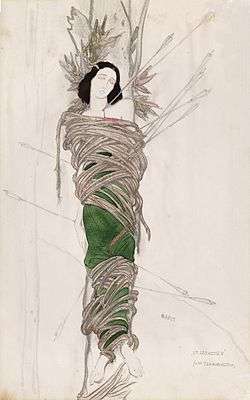Le Martyre de saint Sébastien

Le Martyre de saint Sébastien is a five-act musical mystery play on the subject of Saint Sebastian, with a text written in 1911 by the Italian author Gabriele D'Annunzio and incidental music by the French composer Claude Debussy (L.124).
Background
The work was produced in collaboration between Gabriele D'Annunzio (at that time living in France to escape his creditors) and Claude Debussy, and designed as a vehicle for Ida Rubinstein. Debussy's contribution was a large-scale score of incidental music for orchestra and chorus, with solo vocal parts (for a soprano and two altos).
Debussy accepted the commission in February 1911. Some of the material was orchestrated by André Caplet.[1] During auditions for the female semi-chorus, the chorus director Désiré-Émile Inghelbrecht suggested, on hearing Ninon Vallin, that she take over the role of the celestial voice. As Rose Féart (who had been engaged) was absent from the general rehearsal, Vallin sang the role and Debussy insisted on her singing it in the production.[1]
The premiere had sets and costumes designed by Léon Bakst, stage direction by Armand Bour and choreography by Michel Fokine. The orchestra was conducted by André Caplet, and Désiré-Émile Inghelbrecht directed the chorus. Alongside Rubinstein as Saint Sébastien, Adeline Dudlay sang La Mère douloureuse, Vera Sargine sang La Fille malade des fièvres, Ninon Vallin was the off-stage voice, Desjardins was the emperor, and Henry Krauss was the préfet.[2]
Though the first Gabriel Astruc production was attended by scandal (the Archbishop of Paris requested Catholics not attend because the dancer playing St. Sebastian was a woman and a Jew), the work was not successful and did not enter the repertoire; thanks to Debussy's score, however, it has been recorded in abridged and adapted versions several times—notably by Pierre Monteux (in French), Charles Munch (in French), Leonard Bernstein (sung in French, acted in English), and Michael Tilson Thomas (in French).
Though Debussy's complete score still exists and can be performed in its original form (including linking narration taken from the original play, if the story is not staged), the work is very seldom heard in this way. More often performed is a four-movement orchestral suite made up of music extracted from the score and subtitled 'Fragments Symphoniques' (Symphonic Fragments). In addition, there are also two short brass fanfares which are sometimes presented with the symphonic fragments.
Mystère en cinq actes
Following the acts of the original play, each section is called a 'mansion'. The narrator sets the scene at the beginning of each section.
- La Cour de Lys (The Court of Lilies)
- La Chambre Magique (The Magic Chamber)
- Le Concile des Faux Dieux (The Council of the False Gods)
- Le Laurier Blessé (The Wounded Laurel)
- Le Paradis (Paradise)
Fragments symphoniques
- La Cour de Lys (The Court of Lilies)
- Danse extatique et Final du 1er Acte (Ecstatic Dance and Finale of the 1st Act)
- La Passion (The Passion)
- Le Bon Pasteur (The Good Shepherd)
Recordings
The work has been recorded several times, in abridged format or with the symphonic music only. The orchestral version, arranged by Caplet, is generally described as Fragments symphoniques, and was published in 1912. Conductors who have recorded this version have included Jean Martinon, Daniel Barenboim and Esa-Pekka Salonen.
In 1953 the first full recording appeared, by the Oklahoma City Symphony Orchestra and Chorale, with soloists Frances Yeend and Miriam Stewart, sopranos, and Anna Kaskas, contralto, conducted by Victor Alessandro.
In the same year almost the complete score was recorded for Decca by Suzanne Danco, Nancy Waugh, Lise de Montmollin, Union Chorale de la Tour-de-Peilz (Chorus master Robert Mermoud), and the Orchestre de la Suisse Romande under Ernest Ansermet; digital remastering at Naxos. In the 1960s, Leonard Bernstein adapted the text and recorded the work with his wife, Felicia Montealegre in the role of Sebastian, and the actor Fritz Weaver as narrator and assuming other speaking roles, with the New York Philharmonic, along with Adele Addison, Virginia Babikian, Marlena Kleinman, Joanna Simon, and The Choral Art Society. The work was given with Bernstein's English-language translation of the D'Annunzio text, with some added narration.
In 1991 it was recorded digitally with soloists Ann Murray, Sylvia McNair, Nathalie Stutzmann, narrator Leslie Caron and the London Symphony Orchestra and Chorus conducted by Michael Tilson Thomas. In 2011 Thierry Fischer, conducting the BBC National Chorus and Orchestra of Wales, recorded the complete score. According to the CD booklet, the latter recording uses the "definitive scholarly version" of the score by Durand (2009), edited by Pierre Boulez and Eko Kasaba.
References
- 1 2 Inghelbrecht D-É. Mouvement Contraire (Chapter XVII, 1911). Editions Domat, Paris, 1947, p214-223.
- ↑ Stoullig E. Les Annales du Théâtre et de la Musique, 37eme année, 1911. Librairie Paul Ollendorf, Paris, 1912.